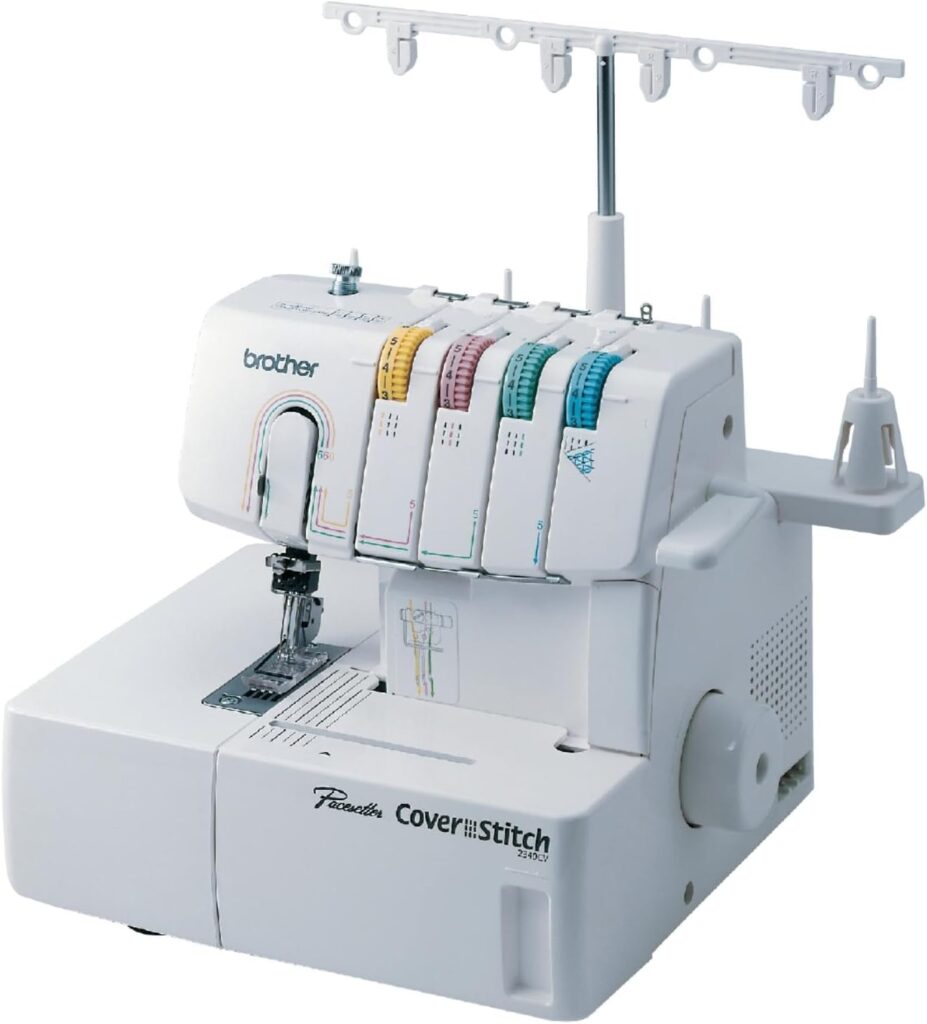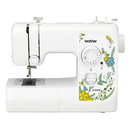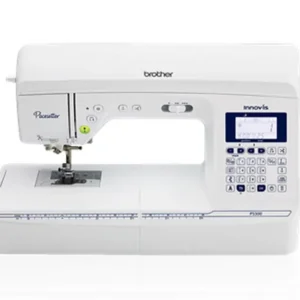
I still remember the afternoon the white box landed on my doorstep. For weeks I’d been deep in “Brother 2340CV reviews,” trying to decide if a dedicated coverstitch was worth the space next to my regular machine and serger. My knit hems were always the giveaway that something was “homemade.” I wanted that clean, stretchy, store-bought look. This is my honest, first-person Brother 2340CV review after living with it and sewing a little bit (okay, a lot) of everything.
Unboxing jitters, quick calm
Out of the box the Brother 2340CV looked simple, almost plain — exactly what I hoped for. No cluttered buttons, just clear, color-coded threading paths printed right on the front. There’s a little lever inside that clicks the looper to the right for threading and back left for sewing. The first time I toggled it I thought, “Oh… that’s clever.” Ten quiet minutes later I had three cones on, the needles threaded, and a scrap of jersey under the foot.
First stitches: from “please work” to “oh wow”
My first test was the narrow two-needle cover hem on a tired T-shirt. I nudged the differential feed a touch above 1 to tame the ripple, lowered the presser foot, and eased into the pedal. The machine purred, not screamed. Flip the fabric over — there it was: neat ladders on the underside, twin lines on top, stretchy and flat. It felt like magic.
I spent the next hour trying everything:
- Narrow and wide two-needle cover hems for tees and cuffs
- The triple cover hem on a thick ponte skirt — so secure
- A single-needle chain stitch to topstitch a knit neckline
Pro tip from my day one: woolly nylon in the looper makes hems extra soft and stretchy. Regular polyester works fine too, but woolly nylon is chef’s kiss for activewear.
The “how do I get this thing out?” moment
If you’ve read any Brother 2340CV reviews, you already know the spicy topic: removing your fabric at the end. My first seam ended with me doing that awkward tug-and-pray move. Don’t. Here’s the simple routine that finally stuck for me:
- Stop with the needles up, lift the presser foot.
- Hold the needle tension releases (one at a time), and pull each needle thread forward a few inches with a tiny screwdriver or a toothpick. Snip those threads near the foot.
- Open the front door, release the looper with the little white lever, then gently pull your project back and to the left at about 45°.
Like a party trick, all the threads hop to the underside. I tie them off or bury them. Once that sequence clicked, ending seams stopped being a drama and turned into muscle memory.
Learning the machine’s personality
Every machine has “a way.” The Brother cover stitch 2340CV likes:
- Fresh needles matched to fabric (stretch or ballpoint for most knits). If you see a random skip, change the needle first.
- Test swatches. Two minutes of testing saves twenty of seam ripping.
- Stabilizer for floaty knits. Tissue paper or wash-away under super lightweight jersey keeps tunneling away.
- Reasonable pace. There’s no speed slider, so I feather the pedal and let the feed dogs do the work.
It also has boundaries. This is not an overlocker; there’s no knife. It shines after you’ve serged or trimmed your edge and you’re ready to hem or bind. I pair it with my serger, and together they’re a little factory.
Real projects, real wins
A few weeks in, I hemmed a stack of family tees in an evening — no popped stitches later. Then I tackled leggings. Crossing thick side seams was my big test. I slowed down, hand-walked a stitch or two at the hump, and the Brother coverstitch 2340CV climbed right over without a hiccup. For a sports bra, I used the triple cover stitch to secure the elastic — solid, comfy, no crackling sounds when stretched.
My favorite make so far? A color-blocked dress for my niece: narrow two-needle hems on the sleeves, chain-stitched topstitching around the neckline, and a wide two-needle hem on the skirt. It looked like it rolled out of an athletic-wear factory.
Tiny hiccups, easy fixes
- Starting “zoom.” The pedal can feel jumpy at the very first touch. I anchor my hands, take a breath, and tap in gently. It settles.
- Tight exit space. There’s no free arm, so hemming tiny tubes takes a little strategy. I turn sleeves inside out so the bulk sits on top and sew “in the round.”
- Light. The built-in light is fine, but I added a small desk lamp to flood the area. Seeing your stitch path is half the battle.
Maintenance + sanity savers
- Brush out lint every few projects. Knits shed.
- Keep a postcard of settings stapled to fabric scraps — jersey, ponte, rib knit — with notes on tension and differential feed. Future-me is grateful.
- Thread looper first, then needles. The machine just behaves better that way.
Six months later: the verdict
After months of hems, bindings, and sporty finishes, the Brother coverstitch serger 2340CV (yes, technically it’s a coverstitch-only machine, but lots of shops label it that way) has paid for itself in time saved and projects I’m proud to wear. It’s not flashy. It does one job and does it well. When I read another Brother 2340CV review that says “simple but solid,” I nod. That’s been my experience.
If you’re comparing Brother 2340CV reviews and wondering whether it’s “enough,” here’s my take:
- If you sew mostly knits and want professional hems that stretch and rebound — yes.
- If you expect it to cut edges or act like a combo machine — no, that’s not what this model is.
- If you’re okay with a short learning curve (especially for thread release) — you’ll be zipping along by the weekend.
Why I’d buy it again
- Clean, reliable cover hems (narrow, wide, triple) and a handy chain stitch
- Color-coded threading plus that click-over looper makes setup fast
- Plays nicely with everything from tissue-thin jersey (with stabilizer) to beefy ponte
- Costs far less than many competitors, without feeling “toy-ish”
If you’re on the fence and combing through every Brother 2340CV review, here’s mine in one line: the Brother 2340CV turned my hemming from a chore I hid from into the neat finish I show off. The stitches look store-bought, they stretch like your fabric does, and once you learn the end-of-seam dance, the machine becomes a steady, dependable teammate.
In short: the Brother coverstitch 2340CV is the quiet hero of my sewing room — no bells, no whistles, just hems that make my knits look pro.
What real customers say in their Brother 2340CV reviews?
| Pros (What people like) | Cons (What people don’t like) |
|---|---|
| Produces clean, professional cover hems (narrow, wide, triple) that look “store-bought.” | Removing fabric is fiddly; manual tension releases per thread, awkward to learn, easy to snag if steps aren’t followed. |
| Has a solid chain stitch option for top-stitching and construction. | Not a true serger (no knife/overlock). Listing can be confusing; some expected trimming. |
| Color-coded threading paths; many users find it easy to thread, especially the looper lever that clicks out for threading. | Reports of skipped stitches or finicky tension — especially on very light knits or mixed fabrics. Often fixed with the right needles/thread/stabilizer. |
| Works especially well on knits/jersey; hems stretch and rebound without popping. | Limited power on very thick/rough fabrics (denim, sequins); some needle breaks at bulky seams. |
| Differential feed helps tame ripples, does gentle gathering, and supports stretch sewing. | No free arm; tight throat space makes small tubes/sleeves trickier. |
| Comes with a clear presser foot — easier to see and align hems in the round. | No speed control; foot pedal can hum then jump into a fast start for some users. |
| Uses standard household needles (e.g., 80/12, stretch/ballpoint); easy to source. | Presser-foot lift doesn’t auto-release tension; must press multiple tension buttons by hand. |
| Great value/price for a dedicated coverstitch; popular as a starter or second machine next to a serger. | Manual/end-of-seam instructions feel unclear; fix often found via YouTube/one-page flyer. |
| Simple, single-purpose design — no conversion from serging to coverstitch. | No automatic tie-off; you’ll pull threads to the back and knot to secure. |
| Handles bulky seam crossings if you slow down or hand-walk a stitch. | Lighting/build: some say it’s noisy/plasticky; a few early bulb failures reported. |
| Time-saver for hemming tees, leggings, activewear; good for small shop/alterations. | Quality control complaints (defective or damaged shipments, “used-like-new” not pristine). |
| Plays nicely with woolly nylon in the looper for softer, stretchier hems. | Warranty/service frustrations when bought online; some dealers won’t service non-dealer purchases. |
| Quick to swap between 6 mm wide, 3 mm narrow, and chain stitch. | Occasional differential feed or looper quirks on individual units. |
| Many users report easy wins right out of the box after a short practice session. | Stabilizer often needed on tissue-thin knits to prevent tunneling; triple cover hem uses lots of thread. |
| Good results across light-to-medium knits, ponte, swim/activewear. | Sensitive to thread quality; cheap cones can cause breakage/bird-nesting. |
Brother 2340CV — Your Most-Asked Questions Answered
What is the Brother 2340CV and how is it different from a regular serger?
Brother 2340CV is a dedicated coverstitch machine made for pro-looking hems, bindings, and topstitching on knits and wovens; it does not trim fabric like an overlock serger and focuses on cover and chain stitches only. This makes it the perfect companion to your standard serger or sewing machine.
Which stitches can I sew on the Brother cover stitch 2340CV?
You can sew a triple coverstitch (three needles, four threads), a two-needle coverstitch in wide 6 mm or narrow 3 mm widths, and a single-needle chain stitch. These are ideal for hemming tees, attaching elastic or tape, and decorative topstitching.
How fast is it and what fabrics does it handle best?
The Brother coverstitch 2340CV runs up to 1,000 stitches per minute and includes differential feed to keep knit hems flat and smooth. Use settings near 0.7–1.0 to help thin fabrics avoid puckering, and above 1.0 to control stretch fabrics and rippling.
What needles and threads should I use?
Use standard home needles: SCHMETZ 130/705H size 90/14. For knits, a ballpoint SUK version helps reduce skipped stitches and fabric snags. Quality cone thread or smooth polyester works well in both needles and looper.
How do I thread the Brother coverstitch serger 2340CV correctly?
Follow the color-coded paths: thread left needle first, then center, then right, and finally the looper. Hold each tension release button while seating the thread in its tension disc, then use the looper release lever to complete looper threading. The order and release buttons matter for reliable stitching.
What is the proper way to remove fabric so I do not jam or unravel?
Stop with needles at their highest point, lift the presser foot, press and hold the tension release for the threads you used, then gently pull the fabric straight back. Trim the needle threads on top, pull back again to draw tails under, and snip the looper thread; tie off on the underside. This simple routine prevents snags and bird’s nests.
What stitch length and width options are available?
Stitch length adjusts from 2–4 mm (most hems look great around 3–4 mm). Width options are 3 mm narrow or 6 mm wide for the two-needle coverstitch; the triple coverstitch is 6 mm.
Can I sew cuffs or other tubular items easily?
Yes. Slide the cuff in, sew in the round, and overlap your start point by about 4 cm before following the fabric-removal steps. Overlapping helps keep the seam secure and prevents popping.
How do I stop tunneling or skipped stitches on light knits?
Based on many Brother 2340CV reviews, the winning combo is: use the right needle type (try a 130/705H SUK ballpoint), test on scraps, adjust thread tensions gradually, reduce presser foot pressure on delicate knits, and fine-tune differential feed to keep hems flat. A lightweight wash-away or tear-away stabilizer under very thin knits can also help.
Can I adjust presser foot pressure and lift height?
Yes. Turn the top-left pressure screw to loosen for very light fabrics or tighten for heavier ones, and the presser foot lift is about 5–6 mm for easier placement over layers and seams.
What comes in the Brother 2340CV box?
You get a soft cover, foot controller, tweezers, cleaning brush, thread nets, spool caps and mats, a hex wrench, a needle set, and a special presser foot for optional attachments, along with the machine itself.
Does the Brother 2340CV have a free arm or fabric cutter?
It is a dedicated coverstitch machine, not an overlock trimmer, so there is no knife to cut fabric. It also does not include a free arm; most owners simply turn sleeves inside out or sew in the round with overlap to finish cuffs cleanly, as echoed in many Brother 2340CV revie
How do I change the bulb and what type does it use?
Unplug the machine, let the cover cool, remove the lamp cover and bulb cover screw, then replace with the same 15-watt bulb. Always power off and allow the bulb area to cool before handling.
Any safety or maintenance tips I should know?
Keep vents clear of lint and fabric, unplug before threading deep, changing needles, or cleaning, and expect normal motor warmth and tiny brush sparks visible through the vent during operation. Regular lint brushing under the cover and around the looper keeps stitches consistent.
Real world pros and cons from a quick Brother 2340CV review of owner feedback
Pros reported: professional knit hems, easy color-coded threading, strong value, and smooth results once dialed in. Cons mentioned: learning curve to release fabric, manual tension release buttons, no free arm, and occasional skipped stitches if set up or needles are off. Reading several Brother 2340CV reviews and practicing on scraps helps you master it fa
Which settings should I try first for common fabrics?
For cotton jersey tees: stitch length 3–4 mm, differential near 1.2–1.5 to tame ripples, standard 90/14 ballpoint, and balanced tensions around 4 as a starting point. For thin rayon knits: lighten presser pressure, try differential near 0.9–1.0, add a scrap of stabilizer, and lower looper tension slightly if tunneling appears. Adjust gradually until the top looks straight and the underside loops look even.
| Feature | Specification |
|---|---|
| Model | Brother 2340CV coverstitch-only household machine |
| Supported stitches | 1-needle, 2-thread double chain stitch 2-needle, 3-thread cover stitch — Narrow 3 mm & Wide 6 mm 3-needle, 4-thread cover stitch — 6 mm |
| Max sewing speed | 1,000 stitches per minute |
| Stitch length range | 2 mm – 4 mm (approx. 5/64″ – 5/32″) |
| Stitch width options (coverstitch) | Narrow 3 mm; Wide 6 mm |
| Differential feed | Adjustable ratio approx. 0.7 – 2.0 (lever on left side) — helps prevent puckering on light fabrics and stretching on knits. |
| Presser foot type | Free presser type; pressure adjustable via top screw |
| Presser foot lift height | Approx. 5 mm – 6 mm (3/16″ – 15/64″) |
| Needle system (recommended) | SCHMETZ 130/705H (90/#14); SUK ball point recommended to help reduce fabric damage |
| Looper threading aid | Front cover opens; looper release lever for easy threading |
| Lighting | Replaceable 15 W bulb (use same type when relamping) |
| Machine net weight | Approx. 7.0 kg |
| Included accessories | Soft cover; tweezers; thread nets (4); spool caps (4); spool mats (4); cleaning brush; hex wrench; needle set; special presser foot (LC1); accessory bag |
| Foot controller | Model N (region-specific part numbers) |




